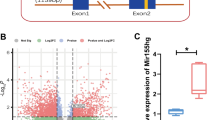Abstract
SUMO-specific proteases 3 (SENP3) is a member of the small ubiquitin-like modifier-specific protease family and deconjugates SUMO2/3 from protein substrates. To date, the expression and function of SENP3 in traumatic brain injury (TBI) are unclear. The present study examined dynamic changes in SENP3 expression in the cerebral cortex and in its cellular localization, using an acute TBI model in adult mice. SENP3 expression was examined at 3, 6, 12, 24 h, 3, and 5 days after TBI using Western Blot analysis and quantitative real-time PCR. Immunohistochemistry and immunofluorescence were examined to detect SENP3 localization. Western Blot indicated that SENP3 protein levels gradually increased from 3 h after TBI and peaked at 24 h. Quantitative real-time PCR demonstrated a gradual increase in SENP3 expression, which peaked 12 h after TBI and declined subsequently. Immunohistochemical staining demonstrated that SENP3-positive cells were observed in both the sham and 24 h post-TBI groups. However, robust expression of SENP3 was seldom observed in the sham group, while it was notably enhanced after TBI. Furthermore, immunofluorescence results revealed that the expression of SENP3 increased more significantly in neurons at day 1 after TBI compared with sham group and less significantly in astrocytes and microglia. Moreover, the SENP3-positive cells that were co-expressed with NeuN also expressed caspase-3, indicating a potential correlation between SENP3 and apoptosis after TBI. Collectively, our results showed obvious up-regulation of SENP3 expression in the brain after TBI, especially in the neurons. However, the full role of SENP3 and its therapeutic potential in TBI needs further investigation.





Similar content being viewed by others
References
Ansari MA, Roberts KN, Scheff SW (2014) A time course of NADPH-oxidase up-regulation and endothelial nitric oxide synthase activation in the hippocampus following neurotrauma. Free Radic Biol Med 77:21–29
Bawa-Khalfe T, Yeh ET (2010) SUMO Losing Balance: SUMO Proteases Disrupt SUMO Homeostasis to Facilitate Cancer Development and Progression. Genes Cancer 1(7):748–752
Carbia-Nagashima A et al (2007) RSUME, a small RWD-containing protein, enhances SUMO conjugation and stabilizes HIF-1alpha during hypoxia. Cell 131(2):309–323
Datwyler AL et al (2011) SUMO2/3 conjugation is an endogenous neuroprotective mechanism. J Cereb Blood Flow Metab 31(11):2152–2159
Dohi K et al (2010) Gp91phox (NOX2) in classically activated microglia exacerbates traumatic brain injury. J Neuroinflammation 7:41
Feligioni M, Nishimune A, Henley JM (2009) Protein SUMOylation modulates calcium influx and glutamate release from presynaptic terminals. Eur J Neurosci 29(7):1348–1356
Flierl MA et al (2009) Mouse closed head injury model induced by a weight-drop device. Nat Protoc 4(9):1328–1337
Fu J et al (2014) Disruption of SUMO-specific protease 2 induces mitochondria mediated neurodegeneration. PLoS Genet 10(10):e1004579
Gong L, Yeh ET (2006) Characterization of a family of nucleolar SUMO-specific proteases with preference for SUMO-2 or SUMO-3. J Biol Chem 281(23):15869–15877
Guo C et al (2013) SENP3-mediated deSUMOylation of dynamin-related protein 1 promotes cell death following ischaemia. EMBO J 32(11):1514–1528
Haindl M et al (2008) The nucleolar SUMO-specific protease SENP3 reverses SUMO modification of nucleophosmin and is required for rRNA processing. EMBO Rep 9(3):273–279
Han Z et al (2014) miR-21 alleviated apoptosis of cortical neurons through promoting PTEN-Akt signaling pathway in vitro after experimental traumatic brain injury. Brain Res 1582:12–20
Lee YJ et al (2011) Elevated global SUMOylation in Ubc9 transgenic mice protects their brains against focal cerebral ischemic damage. PLoS ONE 6(10):e25852
Li GZ et al (2011) Expression of myeloid differentiation primary response protein 88 (Myd88) in the cerebral cortex after experimental traumatic brain injury in rats. Brain Res 1396:96–104
Li W et al (2014) Elevated cerebral cortical CD24 levels in patients and mice with traumatic brain injury: a potential negative role in nuclear factor kappab/inflammatory factor pathway. Mol Neurobiol 49(1):187–198
Martin S et al (2007) Emerging extranuclear roles of protein SUMOylation in neuronal function and dysfunction. Nat Rev Neurosci 8(12):948–959
Miyamoto K et al (2014) PACAP38 suppresses cortical damage in mice with traumatic brain injury by enhancing antioxidant activity. J Mol Neurosci 54(3):370–379
Mukhopadhyay D, Dasso M (2007) Modification in reverse: the SUMO proteases. Trends Biochem Sci 32(6):286–295
Nakagawa A et al (2011) Mechanisms of primary blast-induced traumatic brain injury: insights from shock-wave research. J Neurotrauma 28(6):1101–1119
Park E et al (2009) An analysis of regional microvascular loss and recovery following two grades of fluid percussion trauma: a role for hypoxia-inducible factors in traumatic brain injury. J Cereb Blood Flow Metab 29(3):575–584
Roozenbeek B, Maas AI, Menon DK (2013) Changing patterns in the epidemiology of traumatic brain injury. Nat Rev Neurol 9(4):231–236
Roth TL et al (2014) Transcranial amelioration of inflammation and cell death after brain injury. Nature 505(7482):223–228
Shi W et al (2011) Traumatic brain injury induces an up-regulation of Hs1-associated protein X-1 (Hax-1) in rat brain cortex. Neurochem Res 36(3):375–382
Tan JA et al (2008) SUMO conjugation to the matrix attachment region-binding protein, special AT-rich sequence-binding protein-1 (SATB1), targets SATB1 to promyelocytic nuclear bodies where it undergoes caspase cleavage. J Biol Chem 283(26):18124–18134
Wei H et al (2012) An upregulation of SENP3 after spinal cord injury: implications for neuronal apoptosis. Neurochem Res 37(12):2758–2766
Wilkinson KA, Henley JM (2010) Mechanisms, regulation and consequences of protein SUMOylation. Biochem J 428(2):133–145
Yan S et al (2010) Redox regulation of the stability of the SUMO protease SENP3 via interactions with CHIP and Hsp90. EMBO J 29(22):3773–3786
Zhao JB et al (2011) Activation of JAK2/STAT pathway in cerebral cortex after experimental traumatic brain injury of rats. Neurosci Lett 498(2):147–152
Author information
Authors and Affiliations
Corresponding author
Rights and permissions
About this article
Cite this article
Yu, Z., Li, H., Yan, HY. et al. Expression and Cell Distribution of SENP3 in Brain Tissue After Traumatic Brain Injury in Mice: A Pilot Study. Cell Mol Neurobiol 35, 733–740 (2015). https://doi.org/10.1007/s10571-015-0169-7
Received:
Accepted:
Published:
Issue Date:
DOI: https://doi.org/10.1007/s10571-015-0169-7




